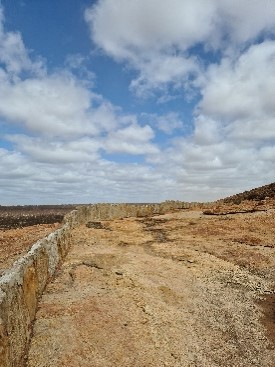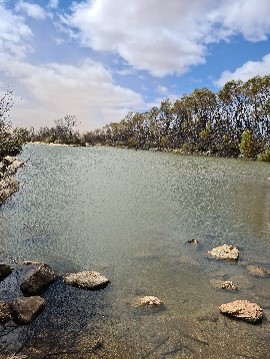Wallaroo Rock Conservation Park
This conservation park is a 1,214 hectare area featuring three historic fresh waters dams that catch water from the granite rock. The water was used for the steam engines of the 1920s called the ‘woodlines’ era. Access to the park is a 39km 4WD track off the Great Eastern Highway, 64km west of Coolgardie. There are campsites, tables, BBQs, disabled access toilet and an information shelter. Please note that pets are not permitted, baits are used in the area and all vehicles must stay on the designated roads.
Rowles Lagoon Conservation Park
Rowles Lagoon is a Conservation Park that is also a popular recreation destination for Goldfields families, visitors and tourists. It is the largest freshwater lake in the Coolgardie bioregion and the lagoon and surrounding areas are a bird waters paradise. They are culturally and environmentally significant and are included in Australia’s register of significant wetlands. The wetlands are an important cultural site for local Aboriginal people and the story of the site is told at the interpretation shelter. There is plenty of sightseeing, swimming and nature observation to be done here, along with tables, toilets, camping sites and BBQs, Rowles Lagoon makes for a wonderful area to go camping with the family of if you just want to get away from it all. It is located 73km north of Coolgardie. Please note that pets are not permitted.
Credo Homestead and Conservation Park
Formerly a pastoral lease established in the early 1900s, Credo is now managed by the Parks and Wildlife Service WA and offers visitors a great opportunity to experience the area with a day or camping trip. With over 200,000 hectares to explore, visitors to the area can sightsee, bushwalk, see the wildflowers and birdlife, snap some great photos and go yabbying in the dams. Credo is also home to a multi-purpose field study center engaged in environmental research. Credo is located 75km North of Coolgardie. Please note that pets are not permitted, and care should be taken around any mining activity.
Cave Hill
One of the largest and highest granite outcrops in the region, Cave Hill provides an area to explore ancient cave formations and pioneering ingenuity with the historic woodline dams on the outcrop. Follow the bushland walking trails to discover all Cave Hill has to offer
Burra Rock Conservation Reserve
Step into the past at Burra Rock where examples of pioneering ingenuity and rusted relics tell intriguing stories of the Goldfields' diverse history.
A catchment wall and dam on the edge of the rock are reminders of area’s vibrant history during the 1920s and 30s. These were built to collect water for the steam trains that hauled timber and firewood along bush railways to the mines, boilers and powerhouses in Kalgoorlie-Boulder. The woodlands have since regrown and now are recognised internationally for their biological diversity. After the woodcutting ceased and the rail lines were dismantled, the water catchment at Burra Rock attracted other pioneers to the region. A collection of abandoned machinery and rusted relics from a small farming venture at Burra Rock in the 1960s can be found in the picnic area.
Visitors are urged not to drive off tracks or on the rock, as historic features and fragile communities of granite plants and animals and are easily damaged.


Burra Rock catchment empty and full.
Victoria Rock Nature Reserve
Victoria Rock is one of the largest granite outcrops in the Great Western Woodlands, take the time while visiting to climb to the top of this giant rock and experience the seemingly endless views. Victoria rock is a popular camping stop for those travelling the Holland Track. Individual campsites accommodate caravans and tents, with fire pits (when fire ratings allow usage) day parking, ablution block and picnic tables provided. No dogs permitted.